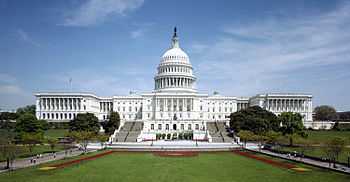1983 United States Senate bombing
Coordinates: 38°53′24″N 77°00′32″W / 38.89°N 77.009°W
| 1983 United States Senate bombing | |
|---|---|
 | |
| Location | Washington, D.C. |
| Date |
November 7, 1983 10:58 pm (UTC-5) |
| Target | United States Senate |
Attack type | bombing |
| Deaths | 0 |
Non-fatal injuries | 0 |
| Perpetrators | Resistance Conspiracy |
| Motive | United States military involvement in Grenada and Lebanon |
The 1983 U.S. Senate bombing was a bomb explosion at the United States Senate on November 7, 1983. Six members of the "Resistance Conspiracy" were arrested in May 1988 and charged with the bombing, as well as related bombings of Fort McNair and the Washington Navy Yard.
Bombing
On that day, the Senate adjourned at 7:02 p.m. A crowded reception, held near the Senate Chamber, broke up two hours later. At 10:58 p.m., an explosion tore through the second floor of the Capitol's north wing; the adjacent halls were virtually deserted.[1]
Minutes before the blast, a caller claiming to represent the "Armed Resistance Unit" had warned the Capitol switchboard that a bomb had been placed near the Chamber in retaliation for recent U.S. military involvement in Grenada and Lebanon.[1]
The force of the device, hidden under a bench at the eastern end of the corridor outside the Chamber, blew off the door to the office of Democratic Leader Robert C. Byrd. The blast also punched a hole in a wall partition, sending a shower of pulverized brick, plaster, and glass into the Republican cloakroom. The explosion caused no structural damage to the Capitol. The force shattered mirrors, chandeliers, and furniture. Officials calculated damages of $250,000 (Nearly $600,000 in 2014).[1]
A portrait of Daniel Webster, across from the concealed bomb, received the explosion's full force. The blast tore away Webster's face and left it scattered across the Minton tiles in one-inch canvas shards. Senate curator James Ketchum recovered the fragments from debris-filled trash bins. Over the coming months, a conservator painstakingly restored the painting to a credible, if somewhat diminished, version of the original.[1]
Aftermath
After a five-year investigation, federal agents arrested six members of the Resistance Conspiracy, on May 12, 1988, and charged them with bombings of the Capitol, Fort McNair, and the Washington Navy Yard.[2] On December 7, 1990, federal judge Harold H. Greene sentenced Laura Whitehorn and Linda Evans to lengthy prison terms for conspiracy and malicious destruction of government property. The court dropped charges against three co-defendants, already serving extended prison sentences for related crimes. Whitehorn was sentenced to 20 years; Evans, to 5 years, concurrent with 35 years for illegally buying guns.[3] On January 20, 2001, the day he left office, President Bill Clinton commuted Evans's sentence.[4]
The 1983 bombing marked the beginning of tightened security measures throughout the Capitol. The area outside the Senate Chamber, previously open to the public, was permanently closed. Congressional officials instituted a system of staff identification cards and added metal detectors to building entrances to supplement those placed at Chamber gallery.
References
- ↑ 1.0 1.1 1.2 1.3 "November 7, 1983: Bomb Explodes in Capitol". United States Senate. Archived from the original on 22 February 2010. Retrieved February 14, 2010.
- ↑ Shenon, Philip (May 12, 1988). "U.S. Charges 7 In the Bombing At U.S. Capitol". The New York Times. Retrieved February 14, 2010.
- ↑ "Radical Gets 20-Year Term in 1983 Bombing of U.S. Capitol". Associated Press. December 8, 1990. Retrieved February 14, 2010.
- ↑ Wong, Edward; Day, Sherri (January 21, 2001). "Former Terrorist Is Among Those Pardoned or Freed in Clinton's Final Acts in Office". The New York Times. Retrieved January 9, 2011.